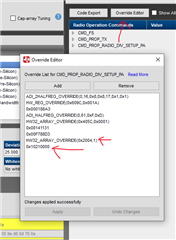Other Parts Discussed in Thread: CC1352R, CC1310, CC1125
Hi Team,
Can you answer the following customer question regarding CC13xx series, please?
1. For compatibility reasons we have to stay with the 434 MHz ISM band and our "old" telegram structure. The data rates are 4.8 kBaud and 19.2 kBaud at RX bandwidths of 10 kHz and 50 kHz and looks like this:
Header 82*0x55, Syncpause (0xFF,0xFF,0xFF),0x01, Data length, Data length, User data (different length), CRC-CCITTL, CRC-CCITTH.
(----- over this range the CRC calculation takes place ----)
We are so far that we can receive our telegram with SmartRF Studio and a CC1312R1 LAUNCHXL board, but there we always get a CRC error. Of course a subsequent CRC calculation in software would be possible, but it would be nice if the SOC would provide this (of course in the above mentioned format).
Here the format used by the µC since then:


We have not yet come to the sending of our telegram - there similar problems are feared.
The header is so long, because we always "listen" successively in 4 frequencies. 3 are working frequencies, there the data are examined for header, the 4th is always another one of our used frequencies and serves for statistical purposes, in order to be able to change in case of disturbances to another channel group.
2. We mainly use arm KEIL MDK5 with µVision in development and are surprised that above mentioned SOCs cannot be programmed with it. According to KEIL only the MSP432 series is supported. Are we wrong there?
3. We took a closer look at the CC1310/CC1312 and CC1352R. Unfortunately, the CC1352R "only" has receiver category 1.5 / 2. Receiver category 1 would be desirable in the security industry. This is not documented for the CC1310, but if I go by the data sheet, it will not achieve receiver category 1 at our data rate/RX bandwidth, especially with regard to blocking.
|
Auszüge aus EN 300 220-1 V3.1. (2017-02) |
|
Table 36: Receiver saturation at adjacent channel |
|
Requirement Limits |
|
Adjacent channel saturation (OCW ≤ 25 kHz) ≥ -20 dBm |
|
Adjacent channel saturation (OCW > 25 kHz) ≥ -10 dBm |
|
Table 38: Spurious response rejection |
|
Requirement Limits |
|
Spurious response rejection (OCW ≤ 25 kHz) ≥ -44 dBm |
|
Spurious response rejection (OCW > 25 kHz) ≥ -34 dBm |
|
NOTE: For spurious response tests separated from the wanted signal by less than |
|
0,1 % of the Operating Frequency, the limits are relaxed by 25 dB. |
|
Table 43: Blocking level parameters for RX category 1 |
|
Requirement Limits |
|
Receiver category 1 |
|
Blocking at ±2 MHz from Centre Frequency ≥ -20 dBm |
|
Blocking at ±10 MHz from Centre Frequency ≥ -20 dBm |
|
Blocking at ±5 % of Centre Frequency or 15 MHz, |
|
whichever is the greater ≥ -20 dBm |
Thank you,
Franz


